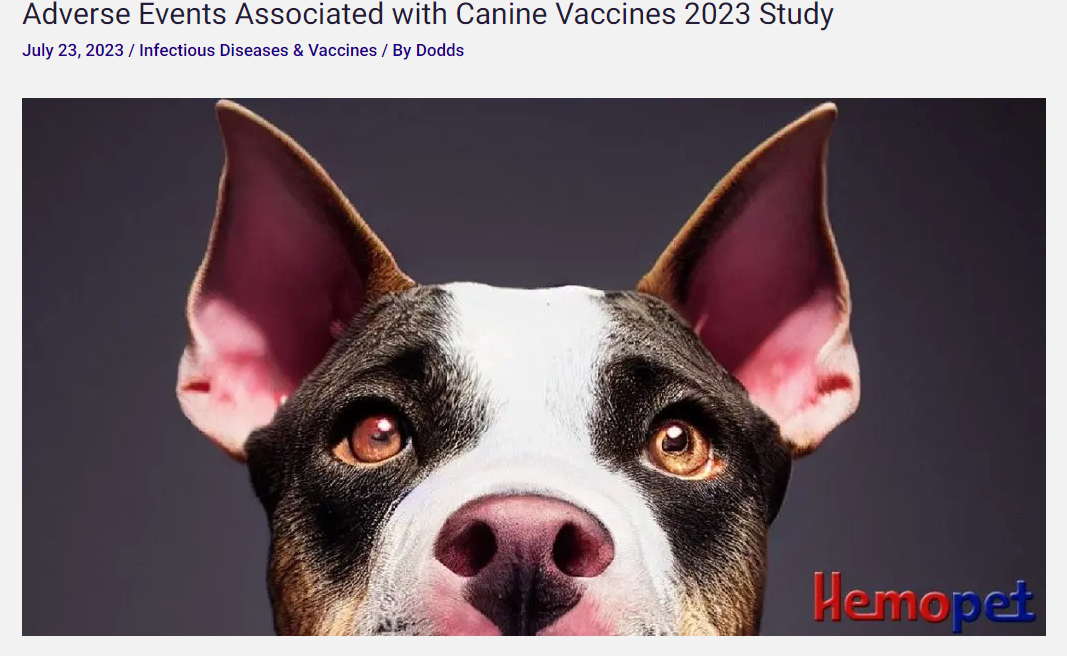Adverse Events Associated with Canine Vaccines 2023 Study
https://mailchi.mp/820bbd429f44/sexy-eggs-16959112
"George Moore and colleagues at Purdue University studied the number of adverse events associated with canine vaccines within 3 days of administration in 2005 that spanned a 2-year time period. That study of the raw data gave a much needed impetus into companion animal vaccine research and helped frame vaccination guidelines for the past two decades.
They concluded in 2005, “4,678 adverse events (38.2/10,000 dogs vaccinated) were associated with administration of 3,439,576 doses of vaccine to 1,226,159 dogs. The VAAE (vaccine associated adverse events) rate decreased significantly as body weight increased. Risk was 27% to 38% greater for neutered versus sexually intact dogs and 35% to 64% greater for dogs approximately 1 to 3 years old versus 2 to 9 months old. The risk of a VAAE significantly increased as the number of vaccine doses administered per office visit increased; each additional vaccine significantly increased risk of an adverse event by 27% in dogs ? 10 kg (22 lb) and 12% in dogs > 10 kg.”
In 2023, Moore published a similar study that covered five years. The conclusions were practically identical, “AEs (adverse events) were recorded following 31,197 vaccination visits (0.19%, or 19.4/10,000 visits). Reported AE rates increased from 1 to 4 vaccines administered and among individual vaccines were greatest for rabies vaccine. AE rate was generally inversely related to body weight, with largest rates in dogs ? 5 kg. The largest AE rates were noted in French Bulldogs and Dachshunds (ORs > 4 compared to mixed-breed dogs).”
The similar conclusions between the studies point out that these factors may impact the possibility of an adverse event in a companion dog:
- body weight
- age
- number of vaccines administered during one visit
- breed
- sex and neuter status
In the discussion portion of the 2023 paper, the researchers wrote, “This study investigated AEs recorded within 3 days following vaccination in > 4.5 million dogs during a 5-year period and provided risk estimates of acute AEs in specific breeds and with individual vaccines. It also found increased AE rate associated with decreased body weight, increasing number of administered vaccines, sex and neuter status, and younger age, as previously reported. Although observed AE rates were less than previously observed overall, direct comparisons are inappropriate.”
We agree that direct comparisons can be inappropriate here because the time periods analyzed were different, breed representation changed due to popularity, separating leptospirosis vaccine from distemper-adenovirus-parvovirus-parainfluenza (DA2PP) vaccine in the 2023 study, and the vaccines administered may be different.
However, the researchers made an unsupported assertion, “Although observed AE rates were less than previously observed overall…” The authors failed to mention, justify or rationalize the most important reason why direct comparisons between the 2005 and 2023 are inappropriate, namely that the data used was different.
In 2005, the prominent data used throughout their research were the number of AEs out of the entire vaccinated dog population in this dataset. So, they took 4,678 AE and divided it by 1,226,159 dogs with the result of 38.2/10,000 dogs vaccinated (0.3815%). They used the same metric for body weight, breed, age, and number of vaccines administered during an office visit.
In 2023, the data did not analyze the number of AEs based on the number of dogs vaccinated. The data were the number of AEs reported based on the total number of office visits that a vaccine was administered. So, 31,197 divided by 16,087,455 resulted in 19.4 AE out of 10,000 visits (19.4/10,000 or 0.194%).
We do think that AE based on visit is more reflective of the actual number of AEs. Do we think the 2005 data are misleading? Not necessarily. If anything, we could say that no matter how one looks at the numbers, the trends are the same: breed, age, sex and neuter status, and number of vaccines given during an office visit are correlated with AEs.
But again, they did not prove that AEs were less in the 2023 study compared to the 2005 study. In fact, we tried to run the numbers to make direct comparisons, but realized that certain key points of confirmatory information were missing from both datasets. For instance, we could glean the total number of vaccines given in the 2023 study, but the authors did not actually state the total number of vaccines as they had in the 2005 study. Secondly, the number of office visits were not provided in the 2005 study.
Bear in mind the researchers were depending upon data provided by the Banfield Hospital network in both studies, and Banfield did not have to provide this information. In the interest of canine health, the hospital network provision of the data is appreciated.
Again, we think the data are solid, but we cannot support the conclusion as explained above of less AEs in the 2023 study compared to the 2005 study.
Leptospirosis
Moore et al. stated in the 2023 study, “While vaccine safety concerns are often expressed anecdotally about leptospirosis vaccines, crude AE rates in this study were not greater for it than for DA2PP or rabies vaccines.”
Yes; according to their statistics, this is true.
However, they removed the key qualifier, bacterin. Indeed, Dr. Ronald Schultz has said, “In addition, of all the bacterin vaccines, leptospirosis causes the most adverse reactions.”
The popular bacterin (bacterial) vaccines for dogs are Bordetella, Lyme, and Leptospirosis. DA2PP and rabies are vaccines against viruses.
So, according to Moore’s statistics regarding bacterin vaccines specifically, Bordetella had the lowest number of reported AEs per doses administered, followed by Lyme, and leptospirosis had the greatest. Thus, proving Dr. Schultz’s comment to be correct.
Bordetella
Moore et al. went into great detail about the route of administration of Bordetella vaccines, but did not clarify if the Bordetella vaccines were strictly Bordetella or Bordetella plus parainfluenza and/or adenovirus-2. Putting that unanswered question aside, 97% of the Bordetella doses were given intranasally. This bolsters a valid point by Moore et al. that they mention in the Introduction and Discussion: i.e. proteins by injection specifically.
Proteins from cattle are often used to help grow canine vaccines. Several studies have shown an increase in reactivity (AE) in companion dogs due to the presence of these proteins. In fact, an analysis of proteins in canine vaccines showed that injectable rabies vaccines had the greatest amount of proteins. Thus, providing a substantive cause, along with the heavy metals such as thimerosal (mercury) salts and aluminum, for Moore et al.’s findings that the most AEs were attributed to rabies vaccines.
Moore et al. point out that manufacturing can reduce or remove these proteins to improve vaccine safety to reduce the occurrence AEs. Remember, the proteins are there simply to grow the culture and are not needed in the final vaccine product. Additionally, the majority of Bordetella vaccines are administered intranasally and they have the lowest AE rates.
Proteins are one major component out of several components causing AEs in companion dogs. As we stated, Bordetella vaccines may have the lowest AE rates, but an AE can still occur with them.
(By the way, intranasal rabies vaccines are not available and should not be developed.)
Meantime
So, while we advocate for manufacturers to reduce or remove proteins and the heavy metals in vaccines, as well as improve the overall product, what can we do in the meantime to help reduce AEs in dogs?
Remember, vaccines not only contain proteins, but also other components such as antigens and heavy metals. Antigens are weakened or inactive parts of a particular organism that triggers an immune response within the body. They are standard and necessary with the currently available vaccine technologies.
Directly quoting Moore et al. (2023): “Increasing the number of vaccines administered at a single visit increased AEs with an approximate 25% increase in adjusted odds of an AE with each additional vaccine added, up to 4. Decreasing body weight also was associated with increased AE rates overall. These 2 findings support a possible relationship between AE occurrence and quantity of vaccine antigens administered relative to body weight, although this relationship appeared minimal in dogs weighing > 15 kg.”
This is a similar finding to the 2005 study. In fact, many veterinarians started reducing the number of vaccinations per visit based on the 2005 study.
One inherent flaw with the 2023 study is that the researchers count DA2PP as one vaccine because it is delivered in one vial. So, the reference to 4 vaccines in the quote might be DA2PP, leptospirosis, Bordetella, and Lyme or another combination.
Yet, DA2PP was associated with the second highest AEs in companion dogs.
Dr. Dodds believes the multivalent DA2PP is actually 4 vaccines in one vial because it is providing protection against 4 different viruses.
Indeed, the vaccination protocols of the American Animal Hospital Association (AAHA) and World Small Animal Veterinary Association (WSAVA) have started diplomatically advocating for the deletion of parainfluenza from DA2PP.
If you are familiar with Dr. Dodds’ Canine Vaccination Protocol, she suggests the bivalent distemper-parvovirus (DPV) vaccine because infectious canine hepatitis (canine adenovirus-2 vaccine provides cross-protection against hepatitis, adenovirus-1) is not clinically relevant at this time.
Regardless of the current protocols, maybe we need to develop a protocol to administer these four-vaccines-in-one-vial separately. Better yet, even Moore et al. mentions personalized vaccination protocols, which nomographs can facilitate, as well as vaccine development or protocol changes for spayed/neutered dogs and female dogs.
Dr. Dodds has advocated for laboratory and clinical trials of smaller doses of all vaccines except for rabies for smaller dogs.
In the meantime, Dr. Dodds’ pilot study has proven that adult companion dogs weighing less than 12 pounds can still mount a response to distemper or parvovirus infection with one-half dose of the bivalent DPV vaccine. However, Moore et al. was reluctant to make this a choice because additional efficacy studies have not been conducted.


